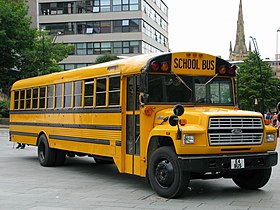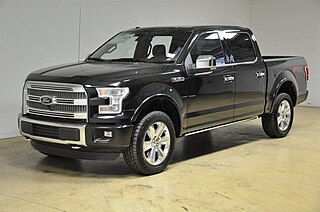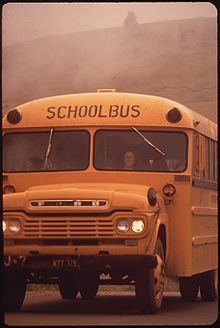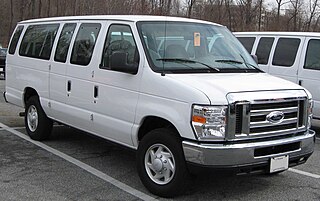
The Ford E series is a range of full-size vans produced by the American automaker Ford since 1960. Introduced for the 1961 model year as the replacement for the Ford F-series panel van, four generations of the model line have been produced. In addition to cargo van and passenger van body styles, the Ford E series has been produced as a cutaway van chassis and stripped chassis.
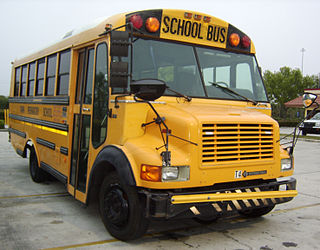
The Thomas Vista is a model line of buses that was manufactured by Thomas Built Buses from 1989 to 1998. Produced nearly exclusively as a school bus, the model line was also sold in commercial-use configurations. To improve forward sightlines for drivers, the chassis of design of the Vista combines elements of conventional buses and transit-style school buses.

The D/W series was a line of pickup trucks that was sold by Dodge from 1961 to 1993. The same basic design was retained until the 1994 introduction of a completely redesigned Ram. The D/W series shared its AD platform with the Dodge Ramcharger/Plymouth Trail Duster twins. 4x2 models were designated D, while 4x4 models were designated W.

The Ford F-Series Super Duty is a series of trucks manufactured by Ford Motor Company. Introduced in 1998 for the 1999 model year, the F-Series Super Duty trucks marked the addition of a heavy-duty pickup to the Ford F-Series range with the new versions of the F-250 and F-350 pickups, while the previous 1987–1997 F-Super Duty chassis cabs were replaced by the F-450 and F-550 Super Duty.
The Chevrolet and GMC B series is a series of cowled chassis that were produced by General Motors, primarily fitted with school bus bodies throughout its production. Based on the medium-duty trucks produced by the Chevrolet and GMC divisions of General Motors, the B series was produced in three separate generations; GMC initially produced its own version separate from Chevrolet. Introduced in 1966, the B series was redesigned in 1984 and 1992 as a 1993 model.

The Chevrolet Kodiak and GMC TopKick are a range of medium duty trucks that were produced by the Chevrolet and GMC divisions of General Motors from 1980 to 2009. Introduced as a variant of the medium-duty C/K truck line, three generations were produced. Slotted between the C/K trucks and the GMC Brigadier Class 8 conventional, the Kodiak/TopKick were developed as a basis for vocationally-oriented trucks, including cargo haulers, dump trucks, and similar vehicles; on later generations, both cutaway and cowled-chassis variants were produced for bus use.

The medium-duty Ford F-Series is a range of commercial trucks manufactured by Ford since 1948. Derived from the smaller F-Series pickup trucks, the medium-duty range is currently in its eighth generation. Initially slotted between the F-Series pickup trucks and the "Big Job" conventionals, later generations were slotted below the L-Series "Louisville" trucks; during its production, the medium-duty F-Series has been used for an extensive number of applications, competing against the medium-duty Chevrolet/GMC C/K, International S-series, and Freightliner Business Class.
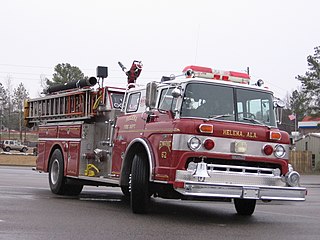
The Ford C series is a range of trucks that was assembled by Ford between 1957 and 1990. The first cab-over engine (COE) truck produced with a tilting cab by Ford, the C-series replaced the C-series COE variant of the F-series, produced since 1948. Produced as both a straight/rigid truck and a tractor, a wide range of versions of C-series was produced, ranging from Class 5 to Class 8 GVWR ratings. The C-series was also used as a basis for fire apparatus production.

The Thomas Saf-T-Liner C2 is a cowled-chassis bus manufactured by bus body manufacturer Thomas Built Buses. Introduced in 2004, the C2 marked the first usage of the Freightliner C2 chassis. While produced largely for school bus use, the C2 is also produced for multiple applications, including specialty and commercial configurations. The C2 is unique in that it is available in capacities up to 81 passengers, the largest of any type C conventional school bus in current production.
The International DuraStar, is a product line of medium-duty trucks produced by Navistar International from 2001 to 2018. Introduced as the successor to the International 4000 series of 1989–2001, the 4000 series was renamed the DuraStar in 2008. Developed as a Class 6-7 product range, the 4000/DuraStar was slotted below the 8000/TranStar regional-haul semitractor, with the Class 5 International TerraStar (2010–2015) serving as the smallest International conventional-cab product range.

The Blue Bird Vision is a bus that is manufactured and marketed by Blue Bird Corporation in North America and exported worldwide. In production since 2003, the Vision became the first cowled-chassis bus built on a proprietary chassis designed and manufactured by the same company. While it is sold primarily in a school bus configuration, the Blue Bird Vision is also offered with various commercial and specialty seating and design configurations.

The Ford L series is a range of heavy-duty trucks that were assembled and marketed by Ford between 1970 and 1998. The first dedicated Class 8 truck produced by the company, the L-series range replaced the N-series short conventional. Produced as both straight trucks and semitractors, the Ford L series encompassed a wide range of models through the Class 7-8 GVWR ratings in medium-duty, severe-service, and vocational applications. The line would become one of the most popular series of trucks Ford ever produced.

The International S series is a range of trucks that was manufactured by International Harvester from 1977 to 2001. Introduced to consolidate the medium-duty IHC Loadstar and heavy-duty IHC Fleetstar into a single product range, the S series was slotted below the Transtar and Paystar Class 8 conventionals.

Multi-stop trucks are a type of light-duty and medium-duty truck created for local deliveries to residences and businesses. They are designed to be driven either sitting down or standing up, and often provide easy access between the driver and goods, hence the name "Walk-In Delivery" van. They are taller than full-size vans such as the Ford Econoline, Dodge A-Series/B-Series/Ram Vans, and Chevrolet G-Series vans, but can have wheelbases that are shorter than these models or longer.
The bus chassis variant of the International S series is a cowled bus chassis that was produced by International Harvester from 1979 to 2004. Produced primarily for school bus applications, the chassis was also produced for other applications, including commercial-use buses and cutaway-cab buses. In addition, the cowled chassis formed the basis for front-engine and rear-engine stripped chassis produced for bus applications.

The International 3300 is a cowled (conventional-style) bus chassis manufactured by Navistar International since 2005 for the United States, Canada, and Mexico. While primarily used for yellow school buses, versions of the 3300 are bodied for other applications as well.

The Freightliner FS-65 is a cowled bus chassis that was manufactured by Freightliner from 1997 to 2007. Derived from the Freightliner FL-Series medium-duty trucks, the FS-65 was produced primarily for school bus applications, though commercial-use buses and cutaway-cab buses were also built using the FS-65 chassis.

The International TerraStar is a product line of medium duty trucks that was manufactured by International Trucks from 2010 to 2015. The smallest conventional-cab truck ever produced by Navistar, the TerraStar is a Class 5 medium-duty truck. Although not officially designated by the company as the replacement for the CityStar LCF cabover, the TerraStar is of similar dimensions and GWVR. Slotted in the Class 5 range, the TerraStar was marketed against both pickup-based vehicles like the Ford F-550 and (Dodge) Ram 5500 as well as conventional-cab trucks like the Freightliner M2, Kenworth T170, and Hino 185.

The ninth generation Ford F-Series is a line of full-size and medium-duty commercial trucks that were produced by Ford from 1991 to 1997. While still based on the basic design dating from late 1979, the 1992 F-Series brought a number of minor changes to the exterior and interior. This is the last generation of the F-Series that was produced as a complete range of trucks from a half-ton pickup (F-150) to a medium-duty Class 6 truck. As this generation was replaced during the 1997–1998 model years, the larger models of the F-Series were split from the F-150; these became the Ford Super Duty trucks, related to the latter with a few powertrain components.

The Freightliner Business Class M2 is a model range of medium-duty trucks produced by Freightliner. In production since June 2002, the M2 was the successor to the FL-Series introduced in the 1990s. In terms of size, the M2 is produced in Class 5 through Class 8 GVWR ratings, competing primarily against the International Durastar and the Ford F-650/F-750 Super Duty.
